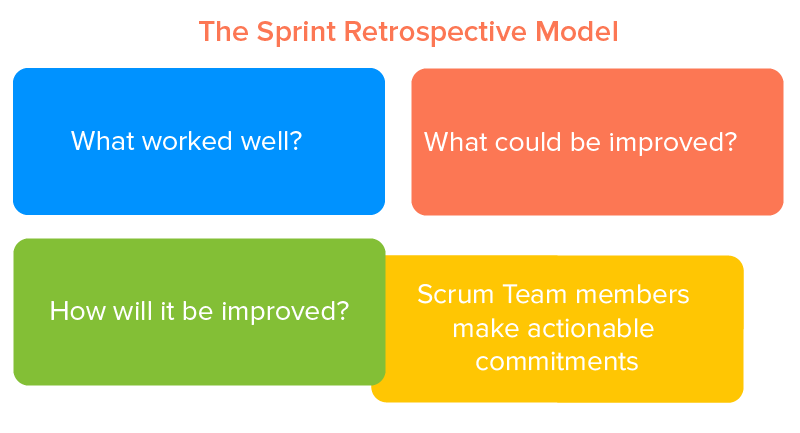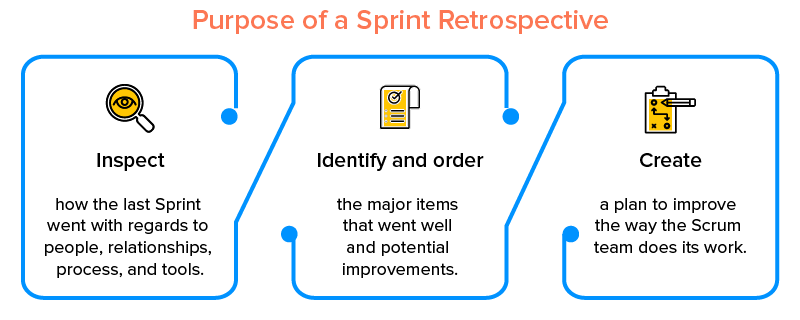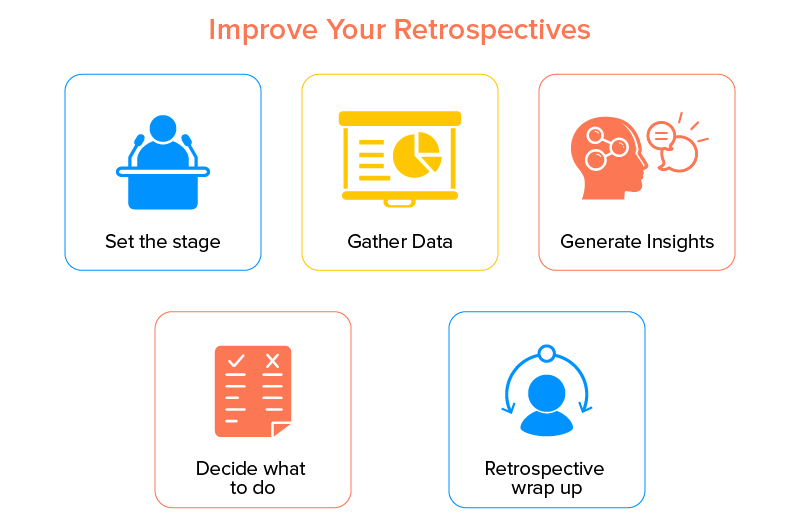Did you ever feel like your team is committing the same mistakes over and over? You feel that they are not moving in the right direction and you need to drive in some change to make the project development process productive.
Whether you are new to software development or you have been working in a custom software development company for years, you must have come across the term ‘Sprint Retrospective’. Agile development teams have made retrospective meetings quite popular.
Regardless of how good a Scrum team is, there is always some room for improvement. Since the focus of agile development is continuous improvement, a good project team sets aside a brief period at the end of each Sprint to reflect how they are doing and seeks out new ways to improve. This is called a Sprint Retrospective.
What is a Sprint Retrospective?
The term retrospective implies looking back or dealing with past events and situations.
According to the Scrum Guide, developed and sustained by Ken Schwaber and Jeff Sutherland “ the Sprint Retrospective is an opportunity for the Scrum Team to inspect itself and create a plan for improvements to be enacted during the next Sprint.”
Well, if you do not know what a Sprint is, a Sprint essentially is a time-boxed period during which a set amount of work is to be completed by the Scrum team. It is at the very heart of Scrum and agile methodologies.
The purpose of a Sprint Retrospective is to identify potential pitfalls and mistakes, evaluate the past working cycle and define actions that may improve things.
A Sprint Retrospective is like a safe space for people to share honest feedback. It is an opportunity to focus on inspection and adaptation. ‘Inspect’ and ‘adapt are the twin mottos of a retrospective and they play a crucial role in making the next Sprint more productive.
Sprint retrospective plays a fundamental role in the scrum framework in agile development. During the sprint retrospective, a team discusses, what went well in the Sprint, what all can be improved and what actions shall be undertaken to improve the next Sprint.

The Value of a Sprint Retrospective
Everything that has an effect on how the Scrum team builds a product such as the practices, processes, tools and communication are open to survey and the retrospective is attended by the product owner, scrum master, development team, and optionally the stakeholders.
Based on the discussions in a retrospective, the team members execute changes and then proceed to the coming sprint with an incrementally improved process.
The best thing about a retrospective is that it happens at the very last when the sprint ends. This way fresh ideas are churned out and teased out by the whole team in the next Sprint.
Afterall, the real purpose of the Sprint Retrospective is to bring about a positive change in the project, team, and organization.

What a project team plans to accomplish with a Sprint Retrospective is pretty much similar to what a football team plans to accomplish in its Monday morning tape review of the weekend’s game. The review is to evaluate how they could have defended better.
Same is the case with a retrospective, it particularly isn’t about winning the game but altering the strategy and implementations to win the next game.
Afterall, even with the best of teams, there’s always some room for improvement.
While a sprint retrospective is essentially an optimised process for teams working in an agile environment, it can be optimised for any type of team that works on a shared project.
During each Sprint Retrospective, the Scrum Team devises ways to improve product design & development quality by improving work processes or adapting the definition of “Done” if it is not in conflict with the product or organizational standards.
Why should you run a Sprint Retrospective?
More often than not, crucial ceremonies in agile such as the retrospective appear very mundane to project teams and as a result they do not use it to their full advantage.
There are a raft of benefits of running an agile sprint retrospective:
- It creates a safe space for team members to share valuable insights and feedback. Retrospectives foster active participation, allow sharing of views and interests, and encourages the team to collaboratively arrive at a solution.
- It provides a platform to document wins, celebrate success and inturn strengthens the team spirit.
- The primary importance of a Sprint Retrospective is that it allows the team to identify potential pitfalls at an early stage and resolve conflict areas. With retrospectives, agile teams can continuously improve the processes by evaluating ‘what all can be improved’.
- By running a retrospective, teams can easily identify small, incremental changes that can cast a huge impact on the overall product. When members share their views for improvement, they feel a sense of ownership.
- Not only team members feel that their opinions are heard and respected, it also cuts through hierarchy and gives equal power to all team members.
- There are many benefits of retrospectives but it is of utmost help to Project Managers. Retrospective aligns teams, keep the project on the right track and make each sprint better than the last. The end of the retrospective allows teams to commence the next sprint with a clean slate.
Difference between a Sprint Retrospective and a Sprint Review
Sprint Review and Sprint Retrospective are often confused as the same thing. However, they are completely different.
Sprint Review
The idea behind working in Sprints is to produce a potentially shippable product increment.
Sprint Review is a meeting where a project team demonstrates the work that they have accomplished. During a Sprint Review meeting, the Scrum Team presents the deliverables of the current Sprint to the Product Owner. The Product Owner then reviews the product increment against the Acceptance Criteria and either accepts or rejects the User Stories.
Sprint Retrospective
In a Sprint Retrospective Meeting, the last Sprint is analysed in terms of the process followed, the tools employed, collaboration and communication mechanisms, and other aspects relevant to the subject.
The team discusses what went well in the previous Sprint, what did not go so well, with the sole aim to make improvements in the next Sprint.

Simply put, the Sprint Review focuses on the product and maximizes the business value of the previous sprints while the Sprint Retrospective focuses on the process and continuous process improvement.
The Sprint Retrospective takes place after the Sprint Review and before the next Sprint Planning. Mostly, it is a three-hour meeting for one-month Sprints.
The Scrum Master ensures that the event is conducted and the attendees understand its very purpose. Since it is an opportunity for the Scrum team to improve, ideally every participant should be present in a Retrospective.
Sprint Retrospective Process
Sprint retrospective is considered one of the most indispensable meetings in Scrum. A well done agile retrospective offers a number of benefits. Here are the five essential steps and tips to make the sprint retrospective better:

- The very first step is to set the stage. Setting the environment, the tone and direction for retrospective is how you start off on the right foot.
- The next step is to gather and analyze the data of previous projects to have insights into previously performed actions. It also entails creating a shared pool of information and highlighting pertinent information and events.
- The third step is to identify repeated patterns and generate insights. By looking at patterns and themes, and identifying pain points and successes it becomes relatively easy to improve the process for everyone in the next Sprint.
- The next stage is deciding a few issues to work on and creating concrete action plans on how to address them.
- The retrospective ends with the acknowledgement and appreciation for the contribution of each member.
Conclusion
The Sprint Retrospective is a critical part of our scrum agile methodology. By running a retrospective we practice the Agile “inspect and adapt” principle.
Retrospective is a great opportunity to motivate a team by providing them the opportunity to speak up, share their ideas, and be heard.
The end goal of our Sprint retrospective meetings is to continually improve a development project, sprint by sprint. It not only improves the quality of the approach, but significantly improves the quality of the product.

strategies your digital product..



